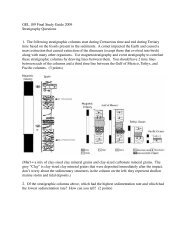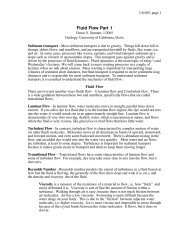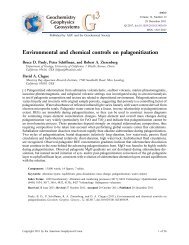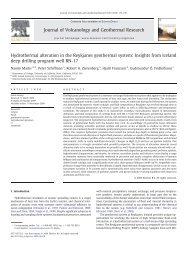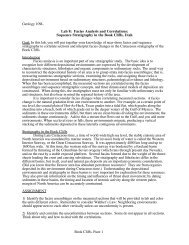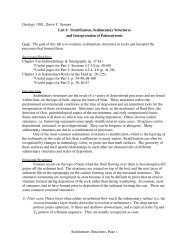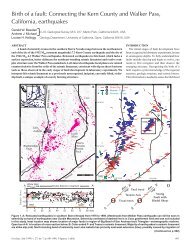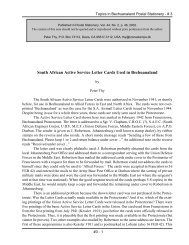ACTA GEOLOGICA SINICA - MyGeologyPage
ACTA GEOLOGICA SINICA - MyGeologyPage
ACTA GEOLOGICA SINICA - MyGeologyPage
Create successful ePaper yourself
Turn your PDF publications into a flip-book with our unique Google optimized e-Paper software.
ssN 1000-9515<br />
Guanling Biota: A Marker of Triassic Biotic<br />
Recovery from the end-Permian Extinction<br />
in the Ancient Guizhou Sea<br />
Jiang Dayong, Ryosuke Motani, Li Chun, Hao Weicheng,<br />
Sun Yuanlin, Sun Zuoyu and Lars Schmitz<br />
Vol. 79 No. 6 2005<br />
<strong>ACTA</strong><br />
<strong>GEOLOGICA</strong><br />
<strong>SINICA</strong><br />
(English Edition)<br />
Journal of the Geological Society of China
Acta Geologica Sinica (English Edition)<br />
Editorial Committee<br />
llonorary Editors-in-Chief:<br />
YangZunyi th&itY<br />
Chen Qingxuan PfiftH<br />
LiTingdong +trffi,<br />
Editor-in-Chief:<br />
ZhaoXun il<br />
f4<br />
Deputy Editors-in-Chief:<br />
Zhai Yusheng tr(d+<br />
Xiao Xuchang H trffi<br />
Liu Jiaqi XIJ#B^H<br />
Yang Zhenyu +hffii<br />
Members of the Editorial Committee (in alphabetical order of the surnames):<br />
An Zhisheng *.if,+,<br />
B.B. de Brito Neves (Brazil)<br />
L. D. Brown (USA)<br />
B. Clark Burchfiel (USA)<br />
Chen Jun P,$ W.<br />
Chen Tingyu<br />
P,6€El<br />
Ding Tiping T'l#+<br />
Ian J. Fairchild (UK)<br />
William S. Fyfe (Canada)<br />
Gabor Gaal (Finland)<br />
Hu Ruizhong AEffiE<br />
Ji Qiang +<br />
9E<br />
Jin Xiaochi #.4'fr<br />
Yu. G. Leonov (Russia)<br />
Liu Jiaqi fU#ffi<br />
Liu Ruixun XUffiJfiJ<br />
Lu Songnian Ptt'^+<br />
MaZonglin qf;tr<br />
Mo Xuanxue HB+<br />
Peng Qiming *{z*nE<br />
Ren Deyi t+4a",Wh<br />
Shi Xiaoying q[nXn<br />
Shu Degan f;1l$+<br />
Wilson Teixeira (Brazil)<br />
Wang Chengshan I'fi*<br />
Wang Pinxian i+ffi41<br />
Wang Sijing IHtr<br />
Wang Tieguan l:Ykfi,<br />
Xiao Xuchang H/i,H<br />
Xu Xing<br />
'I*<br />
E<br />
Yan Fengzeng LlllttJH<br />
Yang Zhenyu thffi+<br />
Yuan Daoxian Ftrfi<br />
Zeng Yishan H[6#<br />
Zhai Yusheng El.h+,<br />
Zhang Guowei tKtri+<br />
Zhao Xun fl<br />
r14<br />
Zheng Yadong XFUA<br />
Zheng Yongfei XJrl( (<br />
Zhong Dalai f+t#<br />
Editorial Board<br />
Director:<br />
Xie Guanglian t ffr€<br />
Members of Editorial Board: Zhu Xiling +AdA<br />
Liu Xinzhu llj,l'ffi<br />
Zhang Yuhua iKl,.ry<br />
Suppofted hy NSFC<br />
Whilst every effort is made by the publishers and editorial department to see that no inaccurate or misleading data, opinion or<br />
statement appear in this joumal, they wish to make it clear that the data and opinions appearing in the articles and advertisements<br />
herein are the sole responsibility of the contributor or advertiser concemed. Accordingly, the publishers, the editors and their<br />
respective employees, officers and agents accept no responsibility or liability whatsoever for the consequences of any such inaccurate<br />
or misleading data, opinion and statement.<br />
All rights reserved.<br />
No part of this publication may be reproduced, stored in a retrieval system, or be transmitted in any form or by any means,<br />
elechonic, mechanical, photocopying, recording or otherwise, without the written permission of the Publisher.<br />
Annual Subscription Rate: US$ 100<br />
Two-year Institutional Rate: US$ 180<br />
pft<br />
cri<br />
skt<br />
Ch<br />
attr<br />
the<br />
tax<br />
I<br />
Gu<br />
the<br />
tha<br />
exc
<strong>ACTA</strong> <strong>GEOLOGICA</strong> SIMCA<br />
Guanling Biota: A Marker of rfiassic Biotic Recovery<br />
from the end-Permian Extinction in the Ancient Guizhou Sea<br />
JIANG Dayongr, Ryosuke MorANI2, LI chun3, HAo weichengt, suN yuanlinr,<br />
SIIN Zuoyul and Lars SCHtvtItZ,<br />
I Department of Geology and Geological Museum, peking university,<br />
Yiheyuan str. 5, Beijing r0087t, china; Email: crjiang@pku.edu.cn<br />
2 Department of Geology, University of California, Davis, California 956l6, USA<br />
3 Institute of vertebrate paleontology and paleoanthropology,<br />
Chinese Academy of Science, 142 Xizhimenwai Street, Beijing 100044, China<br />
Abstract<br />
After a slow recovery from the end-Permian extinction during the Early Triassic and rapid radiation in the<br />
Middle Triassic, evolution of organisms reached a new peak phase in the Late Triassic. The Guanling Biota from the<br />
Wayao Member (cono dont Paragondolella polygnathifurmis Zone),Falang Formation, Xinpu, Guanling bounty, Guizhou<br />
Province, southwestern China corresponds to this peak that marks the full recovery from the end-permian extinction of<br />
marine ecosystems. The biota is of high diversity, containing well preserved and completely articulated skeletons of<br />
vertebrates comprising marine reptiles, fishes, and invertebrates including crinoids, urn*onit.., biuulu.*, and other fossils,<br />
and is one of the best examples of marine ecosystem records in life history. The fossil marine reptiles and crinoids are most<br />
significant in this biota, especially the marine reptiles, which provide an important link between the Triassic pacific and<br />
Tethys, and between Triassic basal forms and the Jurassic-Cretaceous marine top predators. The most remarkable fossils<br />
are the large completely articulated ichthyosaur skeletons up to and more than 10 m, and the first recorded thalattosaurs<br />
and placodonts in China. Following our review, of the l7 named reptilian taxa the eight listed here are considered to be<br />
valid: three ichthyosaurs (Qianichthyosaurus zhoui Li, 1999; Guizhouichthyosaurus tangae Cao and Luo rn yin et al.,<br />
2000, Guanlingsaurus liangae Yin in Yin et a1.,2000), three thalattosarrs (Anrhunsourus huangguoshuensisliu, 1999,<br />
Xinpusaurus suni Yin in Yin et al., 2000, Xinpusaurus kohi Jtutg et a1.,2004), and two placodonts (sinocyamodus<br />
xinpuensis Li,2oo0' Psephochelys polyosteodermaLt and Rieppel, 2oo2). Mixosaurus guanlingensis cao in yin et al.,<br />
2000 might be a junior synonYrn of Qianichthyosaurus zhouiLi, lggg, and Cymbospondylus asiaticus Li and yotr,2oo2<br />
and Panjiangsaunts epichnris Chen and Cheng, 2003 might bejunior synonyrns of Guizhouichthyosaurus tangae cao and<br />
Luo in Yin et al., 2000. It needs to re-describe the holotypes after a comjlete preparation for clarifying the taxonomic<br />
status of rypicusichthyosaurus tsaihuae Yu in Yin et al., 2000, Xinpusauris bamaolinensis Cheng,20o3-, Neosinosaurus<br />
hoangi (Zhott' in Yin et al., 2oo}\,Wayaosaurus geeiZhor: in Yin et al., 2000, Wayaosaurus bellusZhortin yin et al., 2000<br />
and Placochelys ? minutus Yin and Luo in yin et al.. 2000.<br />
Key words: Guanling Biota, marine reptiles, Late Triassic, camian, Guizhou. china<br />
l lntroduction<br />
The Guanling Biota is characterized by abundant, well_<br />
preserved Late Triassic fossils notably marine reptiles and<br />
crinoids, and especially complete articulated ichthyosaur<br />
skeletons of large-size up to more than l0 m and the first<br />
Chinese thalattosaurs and placodonts. This fauna is<br />
attracting more and more interest from scientists all over<br />
the world and thus the time is right for a review of the<br />
taxonomic diversity.<br />
Mu's (1949) description of several crinoid species from<br />
Guanling can be considered as the frrst scientific report of<br />
the Guanling Biota. However, it was not until the late 1990s<br />
that the extent of the biota was fully recognized, following<br />
excavations of numerous marine reptile fossils by local<br />
farmers. Li (1999) and Liu (1999) first reported marine<br />
reptiles from the Guanling Biota. Since then, several<br />
international research groups, including the Institute of<br />
Vertebrate Paleontology and paleoanthropology of the<br />
Chinese Academy of Sciences (IVpp), Department of<br />
Geology and Geological Museum of peking University<br />
(GMPKU), and rhe Yichang Institure of Geology and<br />
Mineral Resource, have been excavating and sfudying the<br />
fossil taxa and biodiversity, stratigraphy and sedimentary<br />
geology, paleoenvironment and paleogeography of this<br />
biota. The fossils were excavated from the Wayao Member<br />
of the Falang Formation at Xinpu in Guanling County,<br />
Guizhou Province, southwestern China (Fig. l; Wang et al.,<br />
2000; Wang et al., 2001; Sun er a1.,2O03; Jiang er al.,<br />
2004a), where the Guanling National Geopark of Fossil
26N<br />
Guizhou<br />
Guanling<br />
0 25 50 75km<br />
25Nlrll<br />
106"E<br />
Biota: Triassic Biotic<br />
l!<br />
't-\-<br />
i<br />
t/!<br />
. Bciiine'?<br />
t- '\ 11<br />
"<br />
ol<br />
) Cuiymg /,<br />
\f._/r<br />
a<br />
0 1500 km<br />
SC-SI<br />
Fig. l. Locality of the Guanling Biota in South Chin;r.<br />
Biota is being constructed.<br />
There are two other important marine reptile faunas in<br />
Guizhou Province, namely the Middle Triassic (Ladinian)<br />
Xingyi Fauna dominated by nothosauroids (Li et a1.,2ffi\<br />
Li and Jin, 2003; Li and Rieppel, 2004) and the Middle<br />
Triassic (Anisian) Panxian Fauna comprising mixosaurid<br />
ichthyosaurs, placodonts, tanystropheiids, and nothosaurs<br />
(Fig. 2; Jiang et al., 2003; Jiang et al., 2004b; Jiang et al.,<br />
2005: Li, 2003; Li et al., 2004). The Guanling Biota is the<br />
most remarkable of the Triassic biota known around the<br />
world in terms of its faunal diversity, preservation and body<br />
size of individual reptiles. Other biota include Monte San<br />
Giorgio, Switzerland and the Germanic Basin in central<br />
Europe; Nevada and British Columbia in the Nonh<br />
America; and Spitsbergen in arctic Norway (e.g. Motani,<br />
1999; Maisch and Matzke, 2000; Rieppel, 2000; McGowan<br />
and Motani, 2003) (Fig. 3).<br />
2 Lge of the Guanling Biota<br />
The Wayao Member of the Falang Formation is<br />
characterized by grayish yellow to dark gray, thin- to<br />
medium-bedded marl, argillaceous limestone and<br />
limestone with some intercalations of black shale and<br />
siltstone. There are several fossil layers yielding abundant<br />
marine reptiles, crinoids and other fossils in the lower part,<br />
mainty in the bed about 8 m above the base of the Wayao<br />
Member, which can be ascribed to the conodont<br />
Paragondolella polygnathiformis Zone (Sun et al., 2003).<br />
Three chronostratigraphic levels for the Guanling Biota<br />
have been proposed:<br />
1) Middle Carnian of the Late Triassic by Chen and<br />
Wang (2002), Sun et al. (2003) and Chen and Cuny (2003)<br />
"'<br />
from the end-Permian Extinction<br />
on the basis of conodont and elasmobranch ichthvolith<br />
biostrati graphic corre lation.<br />
2) Early or late period of early Carnian of the Late<br />
Triassic by Hao et al. (2003) and Xu et al. (2003) on the<br />
basis of cephalopod stratigraphic correlation.<br />
3) Late period of late Ladinian of the Middle Triassic<br />
based on bivalve (e.g., Hsti, 1944);the view is still held by<br />
some researchers.<br />
The two most recently proposed levels of the above three<br />
agree that the Guanling Biota represents a part of the Late<br />
Triassic Carnian and this view is adopted here. There is no<br />
age dating by radiogenic isotopes for the Guanling Biota<br />
available. From the Geological Time Scale 2004 of the<br />
International Cornmissivn of Stratigraphy (Gradstein et al.,<br />
2005), the range of the Carnian is taken as23V2l6 Ma. We<br />
presume that the age of the Guanling Biota is arcnnd 225<br />
Ma given its early Carnian or middle Carnian level.<br />
3 Taxa in the Guanling Biota<br />
3.1 Marine reptiles<br />
The most remarkable animals in the Guanling Biota ere<br />
the marine reptiles, including ichthyosaurs, thalattosaurs,<br />
placodonts and possibly other sauropterygians. Li and Jin<br />
(2003) gave a brief comment on this fauna. The study of the<br />
marine reptiles of the Guanling Biota is still at its beginning.<br />
Till now, 17 endemic taxa of marine reptiles have been<br />
erected; of these some should be re-studied and comparison<br />
made in detail with those elsewhere, and the taxonomic<br />
status of others needs to be confirmed. Given this<br />
complicated situation, we temporarily use the term of<br />
taxonomic name, instead of taxon, in this paper.<br />
Ichthyosaurs<br />
Ichthyosaurs are a group of fish-shaped diapsid reptiles<br />
that first appeared in the late Early Triassic; they became<br />
especially adapted to live in Mesozoic marine<br />
environments.<br />
Taxonomic names l, 2 (It does not mean they are true<br />
synonyms. For more information see description in the<br />
text.)<br />
Ichthyosauria De Blainville, 1835<br />
Toretocnemidae Maisch and Matzke, 2000<br />
Qi anic hthy o s auru s Li, 1999<br />
Qianichthy o s aurus zhoui Li, 1999<br />
Mixosauridae Baur, 1887<br />
Mixosaurus Baur, 1887<br />
Mixosaurus guanlingensis Cao in Yin et al., 2000<br />
c<br />
1<br />
s<br />
ft<br />
a<br />
a<br />
N<br />
tl<br />
T<br />
S<br />
gt<br />
m<br />
s)<br />
m<br />
T:<br />
Ic<br />
M<br />
SI
Vol. 79 No. 6 <strong>ACTA</strong> <strong>GEOLOGICA</strong> SIMCA Dec.2005 731<br />
Time scale<br />
Carbon isotopes<br />
DasYclad<br />
scleractinian<br />
Global diversity Largest atgae<br />
corals (so.)<br />
(boundary crossing<br />
'<br />
lcrown (gen.) Calcareous<br />
genera) gastropods<br />
(sp.)<br />
Late<br />
riassic<br />
a<br />
b0<br />
241<br />
24',7<br />
i<br />
i<br />
l<br />
i<br />
;<br />
lMiddle<br />
L.<br />
ilnasslc<br />
{<br />
i<br />
I<br />
;<br />
:<br />
I<br />
251.4<br />
202468<br />
6"C"^(%o)<br />
Fig. 2. Stratigraphic horizons of the Guanling Biota, Xingyi Fauna and Panxian Fauna in the biotic recovery from<br />
the end-Permian extinction.<br />
Modified with permission from Fig. 3 of Payne et al. (20O4), original coppight 2004 by the American Association for the Advmcement<br />
of Science.<br />
Li (1999) first reported a new genus and species in the<br />
Guanling Biota: Qianichthyosaurus zhouiLi, 1999 (Plate I-<br />
1), a small ichthyosaur specimen of less than 2 m long. Yin<br />
et al. (2000) briefly recognized additional referred<br />
specimens in size from 0.5 m to 2 m. Nicholls et al. (2002)<br />
re-described and presented detailed anatomical information,<br />
and agreed with Maisch and Matzke (2000) to unite<br />
Qianichthyosaurus zhoui Li, 1999 with Toretocnernus<br />
califurnicus Merriam, 1903 from the Carnian in California,<br />
North America in the family Toretocnemidae. Furthermore,<br />
they inferred that Qianichthyosaurus is more derived than<br />
Toretocnemus.<br />
Cao in Yin et al. (2000) assigned a small ichthyosaur<br />
specimen of I.27 m long to a new species Mixosaurus<br />
guanlingensis. Its taxonomic status remains uncertain, but<br />
most probably it is not a mixosaur because no<br />
synapomorphy of Mixosaurus can be distinguished and<br />
might be ajunior synonym of Qianichthyosaurus zhoui.<br />
Taxonomic names 31 4, 5<br />
Ichthyosauria De Blainville, 1835<br />
Merriamosauria Motani, 1 999<br />
Shastasauridae Merriam 0902\<br />
Guizhouichthyosaurus Cao and Luo in Yin et al., 2000<br />
Guizhouichthyosaurus tangae Cao and Luo in Yin et a1.,<br />
2000<br />
Cymbospondylus Leidy, 1 868<br />
Cymbospondylus asiaticus Li and You,2002<br />
Panjiangsaurus Chen and Cheng, 2003<br />
Panjiangsaurus epicharis Chen and Cheng, 2003<br />
Many large ichthyosaur specimens with various total<br />
lengths from 5 m to more than 10 m have been excavated<br />
from Guanling. They represent the most remarkable<br />
members of the Guanling Biota. Three species were erected,<br />
namely Guizhouichthyosaurus tangae Cao and Luo in Yin<br />
et at., 2000, Cymbospondylus asiaticus Li and Yol,20O2<br />
(Plate I-2; Li and You, 2002), and Panjiangsaurus<br />
epicharis Chen and Cheng,2003 (Chen and Cheng, 2003).<br />
The three species have long snouts, and their presacral<br />
vertebral count when known is about 62-65 . Distinguishing<br />
characters among the three have not been clarified, and<br />
therefore a possibility exists that the latter two might be
p<br />
T<br />
r(<br />
fi<br />
A<br />
T<br />
T<br />
T<br />
A<br />
A.<br />
d)<br />
At<br />
t)L Guanling Biota: Triassic Biotic Recovery from the end-Permian Extinction Jiang et al<br />
I<br />
1<br />
Fig. 3. Paleogeographic position of the Guanling Biota.<br />
Paleogeographic map from Scotese (2001) and see also Scotese, C.R., 2002., htp://www.scotese.com (PALEOMAP website)<br />
I<br />
o<br />
V<br />
t<br />
r(<br />
0t<br />
bt<br />
5'l<br />
cli<br />
rel<br />
As<br />
Fig. 4. Lithofacies paleogeographic position of the Guanling Biota in southern China.<br />
Dark yellow rea: old land; yellow rea: clastic deposit platform; light blue area: carbonate platform; dark blue mea: deeper basin<br />
Lithofacies Paleogeographic map from Feng et al., 1997, Appendix figure 4.<br />
Ta<br />
Th<br />
Th<br />
Xi,
Vol. 79 No.6 <strong>ACTA</strong> <strong>GEOLOGICA</strong> SIMCA Dec.2005 733<br />
junior synonyms of G. tdngae. Given that the two skulls of<br />
C. asiaticus were described in detail by Li and You (2002),<br />
it is imporant to redescribe the type specimens of G. tangae<br />
and P. epicharjs. A detailed comparison can be then made<br />
to solve the taxonomic problem.<br />
Taxonomic names 6,7<br />
Ichthyosauria De Blainville, 1835<br />
Merriamosauria Motani, 1999<br />
Shastasauridae Merriam ( 1902\<br />
Guanlingsaurus Yin in Yin et a1., 2000<br />
Guanlingsaurus liangae Yin in Yin et al., 2000<br />
Typicusichthyosaurus Yu in Yin et al., 2000<br />
Typicusichthyosaurus tsaihuae Yu in Yin et al., 2000<br />
Guanlingsaurus liangae, with more than 80 presacral<br />
veftebrae, appears to be a distinct type oflarge ichthyosaur<br />
and different from Guizhouichthyosaurus tangae because it<br />
presents more presacral vertebrae than latter.<br />
Typicusichthyosaurus tsaihuae is a third genus and species<br />
of large ichthyosaur described in Yin et al. (2000), which<br />
was reported to have about 68 presacral vertebrae. Its<br />
taxonomic status can only be clarified through further<br />
research.<br />
Thalattosaurs<br />
Thalattosaurs are a group of lizard-shaped diapsid<br />
reptiles with a long tail, which were formerly known only<br />
from the Middle-Upper Triassic of Europe and North<br />
America, with a possible occurence from the Lower<br />
Triassic of Canada.<br />
Taxonomic name 8<br />
Thalattosauria Merriam, 1904<br />
Askeptosauridae Kuhn-Schnyder, 1952<br />
Anshunsaurus Liu, 1999<br />
Anshunsaurus huang guo shuensis Lilu, 1999<br />
Liu (1999) reported the first specimen of this mysterious<br />
group from Guanling, reaching nearly 3 m in total length,<br />
but he described it as a pistosaurid sauropterygian (Plate I-<br />
5). Rieppel et al. (2000) re-described this taxon and<br />
clarified its status as a thalattosaur and suggested a close<br />
relationship to the Middle Triassic basal thalattosaur<br />
Askepto saurus italic us from Europe.<br />
Taxonomic names 9, 10, 1L<br />
Thalattosauria Merriam, I 904<br />
Thalattosauridae Merriam, 1 905<br />
Xinpusaurus Yin in Yin et al., 2000<br />
Xinpusaurus suniYin in Yin et al., 2000<br />
Xinpusaurus bamaolinensis Cheng, 2003<br />
Xinpusaurus kohi Jiang et al., 2OO4a<br />
Yin in Yin et al. (2000) reported a new taxon<br />
Xinpusaurus suni and briefly described it from four<br />
articulated skeletons with a size range of l.4l-2.38 m, but<br />
attributed it to the ichthyosaurian family<br />
Cymbospondylidae. Liu (2001), Liu and Rieppel (2001,<br />
Plate I-6), and Luo and Yu (2002) re-described and<br />
attributed the species to Thalattosauria. Liu and Rieppel<br />
(2001) also presented a phylogenetic analysis of<br />
thalattosaur relationships. Cheng (2003) briefly reported a<br />
second species of the genus Xinpusaurus, X.<br />
bamaolingensis with a very long snout. Jiang et al. (2O0/.a)<br />
described the third species ofthis genus, X. kohi (Plate I-7),<br />
and analyzed thalattosaurian interrelationships based on 30<br />
cranial and postcranial characters. Their phylogenetic tree<br />
corroborated a sister-group relationship between<br />
Xinpusaurus and Nectosaurus from the Carnian of<br />
California, USA.<br />
Taxonomic names 12, 13, 14<br />
Neosinosaurus hoangi (Zhou in Yin et al., 2000)<br />
Wayaosaurus geeiZhot in Yin et a1.,2000<br />
Wayaosaurus bellus Zhou in Yin et al., 2000<br />
Zhou in Yin et al. (2000) erected the three taxa above and<br />
assigned them to a new family of pachypleurosauriod<br />
sauropterygian, Sinasauridae (Neosinasauridae in Yin and<br />
Zhou, 2000). Preliminary observations suggest that they<br />
may indeed be thalattosaurs, and more detailed preparation<br />
and descriptions are needed to clarify their taxonomic<br />
status.<br />
Sauropterygians<br />
Placodont sauropterygians, a group of Triassic marine<br />
reptiles with characteristic crushing teeth, were formerly<br />
only known from the western Tethys.<br />
Taxonomic names 15, 16, 17<br />
Sauropterygia Owen, 1860<br />
Placodontia Cope, 1871<br />
Cyamodontoidea Nopcsa, 1923<br />
Family incertae sedis<br />
Sinocyamodu,s Li. 2000
734 Guanling Biota: Triassic Biotic Recovery from the end-Permian Extinction Jiang et al.<br />
Sinocyamodus xinpuensis Li, 2000<br />
Placochelysidae Romer, I 956<br />
Psephochelys Li and Rieppel, 2002<br />
P sephochelys polyosteoderma Li and Rieppel, 2002<br />
Placochelys ? minutus Yin and Luo in Yin et a1., 2000<br />
The turtle-shaped Sinocyamodus xinpuensis (Plate I-3)<br />
was the first placodont discovered in China and outside the<br />
western Tethys (Li, 2000). Li and Rieppel (2002) reported<br />
another taxon of placodont, Psephochelys polyosteoderma<br />
(Plate I-4), and discussed the idea that "Placochelys?<br />
minutes" named by Yin and Luo in Yin et al. (2000) was<br />
not clearly a member of the genus Placochelys, and in<br />
addition, that its relationship with Sinocyamodus<br />
xinpuensis was not clear.<br />
3.2 Fossil fishes<br />
There are also abundant fossil fishes with well-preserved<br />
and completely arliculated skeletons of up to and more than<br />
1 m in the Guanling Biota. No description on these fish has<br />
yet been published.<br />
Chen and Cuny (2003) reported abundant elasmobranch<br />
ichthyoliths (microscopic shark teeth and dermal denticles)<br />
across the horizon containing the Guanling Biota, including<br />
a single tooth possibly of a shark of the family<br />
Hybodontidae as well as seven paragener and paraspecies<br />
of dermal denticles.<br />
3.3 Crinoids<br />
Another remarkable group in the Guanling Biota is the<br />
crinoids, represented by numerous well-preserved fossils.<br />
Mu ( 1949, 1957) recognized six taxa: Traumatocrinus hsui,<br />
T. unifurmis,T. hueichouensis,T. hsuivar. enormis,T. aff .7.<br />
timorensis, and Z sp. Yu et al. (2000) erected a new species:<br />
T. guanlingensis, and recognized T. hsui and T. unifurmis.<br />
Wang et al. (2002) reported another new species: Z.<br />
xinpuensis. Wang et al. (2003) argued that all crinoid<br />
specimens in the Guanling Biota should be assign to a<br />
single species, Traumatocrinus hsui Mu 1949, and that "the<br />
juvenile Traumatocrinus hsui lived a pseudoplanktonic<br />
life".<br />
3.4 Cephalopods<br />
From the Zhuganpo and Wayao members of the Falang<br />
Formation at Guanling, a cephalopod sequence has been<br />
discerned. Hao et al. (2003) recognized four genera and<br />
eight species of ammonites and one genus and species of<br />
nautiloid, including Protrachyceras? sp., Trachyceras sp. A,<br />
Z sp. B, T. multituberculatum Hsii, 1940, T. uraniae<br />
Mojsisovics, 7893, Arcto sirenite s canadensis Tozer, 1961,<br />
Arctosirenites columbianus Tozer, 1994, Aust rotrachy ce ras<br />
triadicum (Mojsisovics, 1893), and Enoploceras? sp. Xu et<br />
al. (2003) reported cephalopods in 11 families, 19 genera<br />
and 3'l species, including three new species. They listed<br />
five ammonoid zones in ascending order as: the Xenop<br />
rotrachyceras primum Zone, the Protrochyceras deprati<br />
Zone, the Protrochyceras costulatum Zone, the<br />
Trachyceras multituberculatum Zone, and the Sirenites cf .<br />
senticosus Zone, and attributed the horizon containing the<br />
Guanling B iota to the Tr ac hy c e r a s mult it ub e rc ul a t um Zone,<br />
which they correlated with the early Early Carnian<br />
Trachyceras aonZone in Europe.<br />
3.5 Bivalves<br />
The "Halobia Bed", named after the enclosed bivalve<br />
fossils by Hsii (1944), was previously used to representhe<br />
strata of the Falang Formation. The bivalves in the<br />
Guanling Biota mainly form the Halobia:'Daonella"<br />
assemblage.<br />
3.6 Conodonts<br />
Conodonts survived from the end-Permian extinction.<br />
but finally became extinct at the end of the Triassic.<br />
Conodonts are important in determining the age of the<br />
Guanling Biota. Wang (2000), Chen and Wang (2002), and<br />
Sun et al. (2003) reported conodonts from Guanling,<br />
including Paragondolella polygnathformis, P. tadpole, P.<br />
navicula navicula, P. foliata foliata, P. jiangyouensis, P.<br />
foliata inclinata, and P maantangensis, which can be<br />
ascribed to the conodont Paragondolella foliata inclinata<br />
Zone, Paragondolella polygnathformis Zone and<br />
Paragondolella tadpole Zone in ascending order.<br />
3.7 Other fossils<br />
There are also fossils of brachiopods, holothurian<br />
sclerites (Chen et a1., 2003), heterochthonous terrestrial<br />
plants (Meng et a1.,2002) in the Guanling Biota.<br />
4 Paleogeographic position of the Guanling<br />
Biota<br />
After the end-Permian extinction, the biosphere started<br />
to recover slowly during the Early Triassic (Erwin, 1994),<br />
when the environment was unstable as indicated by the<br />
large perturbations ofthe carbon cycle preserved in marine<br />
sediments (Payne et al., 2004). The marine ecosystem<br />
stabilized in the Middle Triassic, and then the organisms<br />
radiated rapidly (Payne et al., 2004). The Panxian and<br />
Xingyi faunas represent this time period (Fig. 2). In the<br />
early Late Triassic, global diversity reached its highest in<br />
the Triassic (Payne etal.,20O4: Fig. 2). The Guanling Biota<br />
(<br />
fl<br />
(<br />
tl<br />
)<br />
(,<br />
a<br />
a<br />
T<br />
d<br />
sl<br />
cl<br />
w<br />
nl<br />
la<br />
sI<br />
gr<br />
al
Vol.79 No.6 <strong>ACTA</strong> <strong>GEOLOGICA</strong> <strong>SINICA</strong> Dec.2005 735<br />
d<br />
),<br />
n<br />
1S<br />
rd<br />
le<br />
in<br />
ta<br />
(Fig. 3) coresponds to this peak phase that marks a full<br />
recovery of marine organismal diversity from the end-<br />
Permian extinction. Reptiles became the top predators in<br />
the marine realm just as dinosaurs began to dominate on<br />
land.<br />
Wang et al. (2000) briefly discussed the scientific<br />
significance of the Guanling fauna fossils, and its<br />
Iithofacies and tectonic position. Rieppel et al. (2000), Li<br />
(2000) and Nicholls et al. (2002\ discussed the<br />
paleogeographic significance of the Guanling Biota.<br />
Ichthyosaurs in the Guanling Biota show closer<br />
relationship with those from the Carnian of North America<br />
(Qianichthyosaurus with Toretocnemus, and<br />
Guizhouichthyosaurus witJn Shonisaurus or Shastasaurus).<br />
Of thalattosaurs, Xinpusaurus appears as a sister group of<br />
Nectosaurus from North America (Jiang et al., 20O4a),<br />
whereas Anshunsaurus shows close relationship to the<br />
Middle Triassic basal thalattosatr Askeptosaurus italicus<br />
from Europe (Rieppel et al., 2000). Of placodonts, they<br />
expanded their geographic distribution from the western<br />
Tethys to China, indicating a close relationship with the<br />
western Tethys (Li, 2000). The Guanling Biota was a<br />
transitional biota between the eastem Pacific and western<br />
Tethys, and located in the carbonate platform near by the<br />
margin of a deeper basin (Figs. 3,4, and Feng et al. 1997).<br />
Lehrmann et al. (2005) also pointed out that the<br />
paleogeographic position of Guanling was in the interior of<br />
the Yangtze Platform and away from the Nanpanjiang<br />
Basin.<br />
5 Prospects for the Future Research on the<br />
Guanling Biota<br />
Among the l7 taxa described from the Guanling Biota,<br />
three ichthyosaurs (Qianichthyosaurus zhoui,<br />
Guizhouichthy o s aurus tangae, Guanling s aurus lian g ae),<br />
three thalattosaurs (Anshunsaurus huangguoshuensis,<br />
Xinpusaurus suni, Xinpusaurus kohi), and two placodonts<br />
(S ino cy amo dus xinpuen s i s, P s ep ho c he ly s p o ly o s t e o de rma)<br />
are currently accepted to stand on their taxonomic status,<br />
although all need further study.<br />
The Guanling Biota undoubtedly surpasses other Late<br />
Triassic faunas in abundance, preservation quality and<br />
diversity of fossils. Especially noteworthy are the complete<br />
skeletons of marine reptiles. The study on this biota will<br />
greatly expand our knowledge of Triassic marine reptiles,<br />
when they were in their early evolutionary stage. Limited<br />
numbers of well-preserved specimens had previously been<br />
known for thalattosaurs and placodonts; the well-preserved<br />
specimens of these two groups in the Guanling Biota will<br />
greatly enhance our understanding of these mysterious<br />
animals. which onlv lived in the Triassic sea. The larse<br />
ichthyosaurs in the Guanling Biota will help us fill the gap<br />
between Triassic and Jurassic forms, and help complete the<br />
link in the evolutionary line. Furthermore, the Guanling<br />
Biota will provide more data to discuss Triassic<br />
paleogeography, paleoenviroments and its coevolutionary<br />
relationship with the biota.<br />
As described above, the Guanling Biota is unique, well<br />
preserved, and scientifically important. To fully expose the<br />
potential ofthis natural treasure, it is first critical to protect<br />
the biota from destruction and exploitation. At the same<br />
time, it is important to systematically collect scientific data<br />
through excavations, detailed stratigraphic investigations,<br />
and specimen preparation. These basic activities will<br />
ultimately form the basis of all future research.<br />
Acknowledgements<br />
Particular thanks go to Profs. Qiang Di, Bai Shunliang,<br />
Wang Xinping, and Yang Shouren of Peking University.<br />
The first author is grateful to Dr. Michael W. Maisch and<br />
Dr. Andreas T. Matzke of Eberhard-Karls-Universitzit<br />
Ttibingen, Germany for their support and help. Financial<br />
support for this study was also provided by the National<br />
Natural Science Foundation of China (Project No.<br />
40302009), and Peking University.<br />
Manuscript received July 1, 2005<br />
accepted July22,2O05<br />
edited by Xie Guanglian and Susan Turner<br />
References<br />
Chen Huiming, Chen Lide, Wang Xiaofeng and Chen Xiaohong,<br />
2003. Discovery of Middle-Upper Triassic holothurian<br />
sclerites from Yongning, Guanling, Guizhou. Geol. Bull. China,<br />
22(4):266-270 (in Chinese with English abstract).<br />
Chen Lide and Cuny, G, 2003. Discovery of the Middle-Late<br />
Triassic elasmobranch ichthyoliths from the Guanling area,<br />
Guizhou, SW China. Geol. Bull. China,22(4):236-247.<br />
Chen Lide and Wang Chengyuan, 2002. Triassic conodonts from<br />
Zhuganpo and "Wayao" formations of Guanling, southem<br />
China. Acta Palaeontologica Sinica, 4l(3): 349-360 (in<br />
Chinese with English abstract).<br />
Chen Xiaohong and Cheng Long, 2003. A new species of largesized<br />
and long-body ichthyosaur from the late Triassic<br />
Guanling biota, Guizhou, China. Geol. Bull. China, 22(4):<br />
228-235 (in Chinese with English abstract).<br />
Cheng Long, 2003. A new species ofTriassic Thalattosauria from<br />
Guanling, Guizhou. Geol. Bull. China, 22(4): 274-277 (in<br />
Chinese with English abstract).<br />
Erwin, D.H., 1994. The Permo-Triassic extinction. Nature,36'7:<br />
231-236.<br />
FengZengzhao, Bao Zhidong and Li Shangwu, 7997. Lithofacies<br />
Paleogeography of Early and Middle Triassic of South China.<br />
Beijing: Petroleum Industry Press, 131-134, Appendix Figure<br />
4 (in Chinese with English abstract).
736 Guanling Biota: Triassic Biotic Recovery from the end-Permian Extinction Jiang et al.<br />
Gradstein, F.M., Ogg, J.G, Smith, A.G., Agterberg, F.P., Bleeker,<br />
W., Cooper, R.A., Davydov, V., Gibbard, P., Hinnov, L., House,<br />
M.R., Lourens, L., Luterbacher, H.-P., McArthur, J., Melchin,<br />
M.J., Robb, L.J., Shergold, J., Villeneuve, M., Wardlaw, B.R.,<br />
Ali, J., Brinkhuis, H., Hilgen, F.J., Hooker, J., Howarth, R.J.,<br />
Knoll, A.H., Laskar, J., Monechi, S., Powell, J., Plumb, K.A.,<br />
Raffi, L, Rdhl, U., Sanfilippo, A., Schmitz, B., Shackleton, N.J.,<br />
Shields, GA., Strauss, H., Van Dam, J., Veizer, J., Van<br />
Kolfschoten, T., and Wilson, D., 2005. Intemational<br />
Stratigraphic Chart (2004). J. Stratig r., 29(2): 97 .<br />
Hao Weicheng, Sun Yuanlin, Jiang Dayong, Yang Shouren and<br />
Wang Xinping, 2003. Cephalopods of the "Falang<br />
Formation" (Triassic) from Guanling and Zhenfeng Counties,<br />
Guizhou Province, China. Acta Geologica Slnica (English<br />
edition), 77 (4): 430439.<br />
Hsti. T.Y.. 1944. Middle Triassic ammonite fbssils in Kueichow.<br />
Geol. Rev., 9(5-6): 275-280 (in Chinese).<br />
Jiang Da-yong, Hao Wei-cheng, Maisch, M.W., Matzke, A.T.,<br />
and Sun Yuanlin, 2005. A basal mixosaurid ichthyosaur from<br />
the Middle Triassic of China. Palaeontology, 48(4): 869-882.<br />
Jiang Da-yong, Hao Wei-cheng, Sun Yuan-lin, Maisch, M.W. and<br />
Matzke, A.T., 2003. The mixosaurid ichthyosaur Phalarodon<br />
from the Middle Triassic of China. Neues Jahrbuch Fur<br />
G e o lo g i e un d P al ao nt o I o g i e, M o nat s heft e, | | : 656-666.<br />
Jiang Da-yong, Maisch, M.W., Sun Yuan-lin, Matzke, A.T., and<br />
Hao Wei-cheng, 2004a. A new species of Xinpusaurus<br />
(Thalattosauria) from the Upper Triassic of China. J.<br />
Vertebrate Paleontol., 24(1): 80-88.<br />
Jiang Da-yong, Schmitz, L. and Hao Wei-cheng, 2004b. Two<br />
species of Mixosauridae (Ichthyosauria) from the Middle<br />
Triassic of south-western China. J. Vertebrate Paleontol.,24<br />
(3, supplement): 764.<br />
Lehrmann, D.J., Enos, P., Payne, J.L., Montgomery, P., Wei<br />
Jiayong, Xiao Jiafei and Orchard, M.J., 2005. Permian and<br />
Triassic depositional history of the Yangtze platform and Great<br />
Bank of Guizhou in the Nanpanjiang basin of Guizhou and<br />
Guangxi, south China. Alb e rtiana, 33 : 149- I 68.<br />
Li Chun, 1999. Ichthyosaur from Guizhou, China Chine.se Sci.<br />
B ull., 44( 14): 1329-1333.<br />
Li Chun, 2000. Placodont (Reptilia: Placodontia) from Upper<br />
Triassic of Guizhou, China. Vertebrata PalAsiatica, 38(4\:<br />
314-317 (in Chinese with English abstract).<br />
Li Chun, 2003. First record of protorosaurid Reptile (Order:<br />
Protorosauria) from the Middle Triassic of China. Acta<br />
Ge o lo g ic a S inic a, 77 (4): 419423.<br />
Li Chun and Rieppel, O.,2002. A new cyamodontoid placodont<br />
liom Triassic of Guizhou, China. Chinese Sci. Bull., 47(5):<br />
403407.<br />
Li Chun, Rieppel, O., and LaBarbera, M.C.,2004. A Triassic<br />
aquatic protorosaur with an extremely long neck. Scienc e, 305'.<br />
1931.<br />
Li Chun and You Hailu, 2002. Cymbospondylas from the upper<br />
Triassic of Guizhou, China. Vertebrata PalAsiatictt, 40(1): 9-<br />
16 (in Chinese with English abstract).<br />
Li Jinling and lin Fan, 2003. New advances of the research on<br />
Keichousaurus reptile fauna. Progress in Natural Science, 13'.<br />
796-800 (in Chinese).<br />
Li Jinling, Liu Jun and Rieppel, O., 2002. A new species of<br />
Lctriosaurus (Sauropterygia: Nothosauridae) from Triassic of<br />
Guizhou, SW China. Vertebrata PalAsiatica, 4O(2): 114-126<br />
(in Chinese with English abstract).<br />
Li Jinling and Rieppel, O.,2004. A new nothosaur from Middle<br />
Triassic of Guizhou, China. Vertebrata PalAsiatica,42(1): 1-<br />
12 (in Chinese with English abstract).<br />
Liu Jun, 1999. Sauropterygian from Triassic of Guizhou, China.<br />
Chinese Sci. Bull., 44(14): 1312-1316.<br />
Liu Jun,2001. Postcranial skeleton ofXinpusaurus. In: Deng Tao<br />
and Wang Yuan (eds.), Proceedings of the Eighth Annual<br />
Meeting of the Chinese Society oJ Vertebrate Paleontology.<br />
Beijing: Chinese Ocean Press, l-7.<br />
Liu Jun and Rieppel O.,2001. The second thalattosaur from the<br />
Triassic of Guizhou, Chtna. Vertebrata PalAsiatica,39(2): 77-<br />
87.<br />
Luo Yongming and Yu Youyi, 2002. The restudy on the skull and<br />
mandible of Xinpusaurus suni. Guizhou Geol., 19:7l-76.<br />
Maisch, M.W., and Matzke, A.T., 2000. The Ichthyosauria.<br />
Stuttgarter Beitrrige zur Naturkunde Serie B (Geologie und<br />
P alciontolo g ie ), 298: | -l 59.<br />
McGowan, C., and Motani, R., 2003. Ichthyopterygia. In: Sues,<br />
H.-D. (ed.), Handbook of Paleoherpetology part 8. Miinchen:<br />
Verlag Dr. Friedrich Pfeil, 1-174.<br />
Meng Fansong, Wang Xiaofeng, Chen Xiaohong, Chen Huiming,<br />
ZhangZhenlu, Xu Guanghong, Chen Lide, Wang Chuanshang<br />
and Sun Yatt,2002. Discovery of fossil plants from Guanling<br />
biota in Guizhou and its significance. -/. Stratigr.,26(3):250-<br />
258.<br />
Motani, R., 1999. Phylogeny of the Ichthyopterygia. J. Vertebrate<br />
P ale ontol., 19 (3): 473496.<br />
Mu, A.T., 1949. On the discovery of the crown of Traumatocrinus.<br />
BulI. Geol. Soc. China.29: 85-92.<br />
Mu A.T., 1957. Crinoidea (A). In: Chen Xu, Ding Daoheng and<br />
Wang Hongzhen (eds.), Index Fossil in China-Invertebrate<br />
Series I. Beijing: Geological Publishing House, 89-95 (in<br />
Chinese).<br />
Nicholls, E.L., Chen Wei and Makoto, M., 2002. New material of<br />
Qianichthyosaurus Li, 1999 (Reptilia, Ichthyosauria) from the<br />
Late Triassic of southem China, and implications for the<br />
distribution of Triassic ichthyosaurs. J. Vertebrate Paleontol.,<br />
224):'759-765.<br />
Payne, J.L., Lehrmann, D.J., Wei Jiayong, Orchard, M.J., Schrag,<br />
D.P., and Knoll, A.H., 20O4.Large perturbations of the carbon<br />
cycle during recovery from the end-Permian extinction.<br />
Science.305: 50G509.<br />
Rieppel, O., 2000. Sauropterygia I. In: Wellnhofer, P. (ed.),<br />
Encyclopedia of Paleoherpetology part l2 A. Mtinchen: Verlag<br />
Dr. Friedrich Pfeil, 1-134.<br />
Rieppel, O., Liu Jun and Bucheq H., 2000. The first record of a<br />
thalattosaur reptile from the Late Triassic of southem China<br />
(Guizhou Province, PR China). J. Vertebrate Paleontol.,2O(3):<br />
507-514.<br />
Scotese, C.R., 2001. Atlas of Earth History, Volume l,<br />
Paleogeography. PALEOMAP Project, Arlington, Texas, 52.<br />
Scotese, C.R., 2002. http://www.scotese.com, (PALEOMAP<br />
website).<br />
Sun Zuoyu, Hao Weicheng and Jiang Dayong, 2003. Conodont<br />
stratigraphic evidence for the age of the Guanling Fauna,<br />
Guizhou Province, China. Acta Scientiarum Naturalium<br />
Universitatis Pekinensis, 39(l): 118-125 (in Chinese with<br />
English abstract).<br />
Wang Baiyan, Bai Zhiqiang, Hao Weicheng, Sun Yuanlin and<br />
Jiang Dayong, 2002. A new crinoid species from the Wayao<br />
Formation of Late Triassic in Guizhou Province. Geoscience.<br />
\\<br />
Xr<br />
Yi<br />
Yi
d<br />
te<br />
tn<br />
JN<br />
)n.<br />
r.),<br />
lag<br />
fa<br />
.na<br />
3):<br />
AP<br />
0nt<br />
na,<br />
um<br />
rith<br />
and<br />
yao<br />
rce,<br />
Vol. 79 No. 6 <strong>ACTA</strong> <strong>GEOLOGICA</strong> <strong>SINICA</strong> Dec. 2005 737<br />
J<br />
tg<br />
tq<br />
L<br />
16(3):231-236 (in Chinese with English abstract).<br />
Wang Chuanshang, Wang Xiaofeng, Chen Xiaohong and Chen<br />
Lide, 2003. Restudy of the crinoids Traumatocrheas of the<br />
Guanling biota, Guizhou. Geol. Bull. China, 22(4): 248-253<br />
(in Chinese with English abstract).<br />
Wang Hongmei,2OOO. Discussion on the age of Guanling fauna<br />
by conodonts. Guizhou Geol., l7 (4): 219-225 (in Chinese with<br />
English abstract).<br />
Wang Liting, Li Jinling, Wang Xinjin, Li Chun, Wu Tianzhuang<br />
and Liu Jun, 2001. Biostratigraphy of Triassic marine reptiles<br />
in Southwest Guizhou and its adjacent area. Acta Geologica<br />
Slnicc (English edition), 7 5(4): 349-353.<br />
Wang Yangeng, Wang Liting and Wang Shangyan, 2000.<br />
Discussion on Guanling fauna fossils and their significance in<br />
Guizhou, China. Guizhou Geol., 17(3): 145-151 (in Chinese<br />
with English abstract).<br />
Xu Guanghong, Niu Zhijun and Chen Huiming, 2003. Triassic<br />
cephalopods from the Zhuganpo and Xiaowa Formations in<br />
Guanling, Guizhou, with a discussion on the age of the<br />
Guanling biota. Geol. Bull. China,22(4): 254-265 (in Chinese<br />
with English abstract).<br />
Yin Gongzheng and Zhou Xiugao, 2000. The early Late Triassic<br />
marine reptile Neosinasaurus nom. nov. from Guanling,<br />
Guizhou, China. Geology-Geochemistry, 28(4): 107-108 (in<br />
Chinese with English abstract).<br />
Yin Gongzheng,Zhou Xiugao, CaoZetian, Yu Youyi and Luo<br />
Yongming, 2000. A preliminary study on the Early Late<br />
Triassic marine reptiles from Guanling, Guizhou, China.<br />
Geology - Geochemistry, 28(3): l-23 (in Chinese with English<br />
abstract).<br />
Yu Youyi, Luo Yongming and Yingongzheng, 2000. Crinoid from<br />
Guanling fauna in Guizhou. Guizhou Geol., l1(l):4G-45 (in<br />
Chinese with English abstract).<br />
Explanation<br />
of Plate<br />
Plate I<br />
7. Qianichthyosaurus zhoui Li, 1999: paratype, IVPP V 11838.<br />
Scale bar: 10 cm.<br />
2. Guizhouichthyosaurus tangae Cao and Luo in Yin et al., 2000:<br />
paratlpe of Cymbospondylus asiaticusLi and You, 2002, IVPP<br />
V 11869. scalebar: 10cm<br />
3. Sinocyamodus xinpuensis Li,2000: holotype, IVPP V 11872.<br />
Scale bar: 10 cm.<br />
4. Psephochelys polyosteodermtt Li and Rieppel,2002: holotype,<br />
IVPP V 72442;4a: skull, 4b: carapace. Scale bar: 5 cm.<br />
5. Anshunsaurus huangguoshuensis Liu, 1999: holotype, IVPP V<br />
| | 835. Scale bar: l0 cm<br />
6. Xinpusaurus suni Yin in Yin et al., 2000: IVPP V 11860. Scale<br />
bar: 5 cm.<br />
7 . Xinpu s auru s kohi J iang et al., 20M : holotype, GMPKU-P- I 005<br />
(former GMPKU 2000/005); 7a: skull, 7b: skeleton. Scale bar:<br />
15 cm.<br />
cf<br />
t.,<br />
'6r<br />
1,
Biota: Triassic Biotic Recove from the end-Permian Extinction Jiang et al.
GUIDANCE FOR CONTRIBUTORS<br />
I' Papers should be devoted mainly to various aspects ofresearch concerning geosciences and related disciplines in China, such as<br />
stratigraphy, paleontology, origin and history of the Earth, structural geology, tectonics, mineralogy, petrology, geochemistry,<br />
geophysics, geology ofmineral deposits, hydrogeology, engineering geology, environmental geology, regional geology and new<br />
theories and technologies of geological exploration. Those of scientific interest to the geological community in China or of<br />
international interest are also welcome.<br />
2' Only unpublished original papers, not simultaneously submitted or published elsewhere, will be accepted, and copyright in<br />
published papers will be vested in the publisher.<br />
3. Papers, including text, text figures, tables, references and plates, are normally 5000 to 10,000 words long, but shorter papers are<br />
encouraged. Printed, they generally total 6-12 pages. Longer papers can be accepted but may incur excess page charges.<br />
4. Papers must be written in English. Chinese authors are requested to submit a corresponding Chinese version for the convenience of<br />
the revisers.<br />
5. The text for a long paper must include the following elements: a. title of the paper; b. author's name, affiliation and a1l relevant<br />
contact address; c. abstract of no more than 200 words; d. key words; e. introduction; f. text; g. discussion; h. conclusion; i.<br />
acknowledgement; j. references; k. brief (maximum of 100 words) biographical sketch of the first author.<br />
6. References cited should follow the style be1ow. These examples includejournal article and book references.<br />
Symons, D.T.A., and Sangster, D.F., 1991. Palaeomagnetic age of .... Economic Geology,86(l): 1*12.<br />
Lee, J.S., 1939. The Geology of China. London: Thomas Murby and Co., 528.<br />
Bowden, P., and Turner, D.C., 1974. Peralkaline and associated ring-complexes .... In: Sorensen, H. (ed.), The Alkaline Rocks.<br />
New York: J. Wiley & Sons, 330-51.<br />
Cheng Yuqi, Wan Yusheng, Gao Jifeng and Ma Rui, 2001. Petrographic characteristics of three anatectically transformed<br />
metamorphic rock types of the Fuping Group-Complex of the Xiaojue Region, Pingshan, Hebei. Geologicat Review, 47(l):<br />
1-8 (in Chinese with English abstract).<br />
References should be listed in alphabetic order and cited in the text with each author's name and year of publication within<br />
parentheses. References other than English, French, Spanish and German should be translated into English, with the specific<br />
original language duly indicated.<br />
7. Line drawings should be made in black ink on white paper or on transparent film. Originats should not be greater than 44 size and<br />
lettering should be capable of being reduced to up to 607a. It is recommended that drawings are processed with CorelDraw or<br />
are readable and editable in CorelDraw. Photographs should be glossy prints or high-resolution fiies readable and editable in<br />
Adobe Photoshop. Tables with text only and without graphics should be placed by the author within the text of the paper for<br />
typesetting.<br />
8. A paper should be submitted in 3 hard copies along with an electronic copy. Always retain a copy of all materials submitted as<br />
backup. When the manuscript is accepted for publication, the author should revise the manuscript according to the opinion of the<br />
Editor. Papers are preferably processed in the format of Microsoft Word 2000 or lower. Text documents are also acceptable.<br />
Number illustrations carefully in soft pencil on the back.<br />
9. The author alone is responsible for the correctness of his paper. When major changes are deemed to be necessary, the Editor will<br />
consult with the author, and the manuscript may be retumed to the author for approval or further clarification.<br />
10. Forty reprints will be provided free ofcharge for each paper.
<strong>ACTA</strong> <strong>GEOLOGICA</strong> <strong>SINICA</strong> (English Edition)<br />
ftF+# (*IHn )<br />
Vol. 79 No. 6 2005<br />
Edited by: Editorial Board<br />
<strong>ACTA</strong> <strong>GEOLOGICA</strong> <strong>SINICA</strong> (English edition)<br />
Geological Society of China<br />
26Baiwanzhuang Rd., Fuwai, Beijing 100037, China<br />
Tel: (010) 68999024; Fax: (010) 68995305<br />
E-mail: geoacta @ public3.bta.net.cn<br />
http :// www. geosociety.org.cn<br />
Published and distributed by: Geological Society of China<br />
26Baiwanzhuang Rd., Fuwai, Beijing 100037, China<br />
Supervised by: China Association for Science and Technology<br />
History ol Acta Geologica Sinica<br />
O ln 1922, the Bulletin of the Geological Society of China (mainly in English)<br />
was established.<br />
O ln 1952, the Bulletin was renamed Acta Geologica Sinica (in Chinese with<br />
English abstracts).<br />
o ln March 1988, Acta Geologica Sinica (English edition) appeared in English<br />
translation of the Chinese edition. lt was separately numbered as was agreed<br />
with its exclusive overseas distributor Pergamon Press so as to be<br />
distinguished from the Chinese edition, but it followed the Chinese translation<br />
by two issues.<br />
o From 1997 on, Acta Geologica Sinica (English edition) has been and will be<br />
numbered in the same way as the Chinese edition. lt will not carry the full text<br />
translation of the Chinese edition in principle but directly carry the English<br />
originals.<br />
ISSN 1000-9515<br />
, lllililJilJilil[lilUll<br />
ltittl'<br />
cN 11-20011P<br />
Dec. 2005



